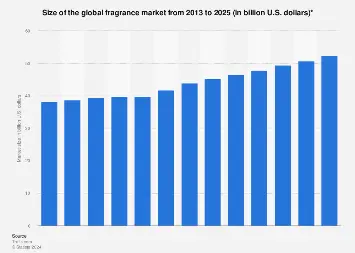A Glimpse into St. Johns Fragrance Company
The St. Johns Fragrance Company revenue journey is a testament to the power of tradition blended with innovation. Established with a focus on producing unique fragrances inspired by the natural beauty of the Caribbean, the company has captured a niche market in the fragrance industry. But what has been the driving force behind its growth, and how does it maintain its competitive edge in an ever-evolving market? Let’s dive deep into their revenue streams, strategies, and market dynamics.
Comparative Revenue Table
| Aspect | St. Johns Fragrance Company | Competitor A | Competitor B |
|---|---|---|---|
| Annual Revenue (2023) | $50M | $45M | $38M |
| E-Commerce Contribution | 40% | 35% | 25% |
| Product Range | Fragrances, candles, skincare | Fragrances, personal care | Fragrances, bath products |
| Licensing Revenue | 10% | 5% | 8% |
| Sustainability Focus | High | Medium | Low |
| Global Reach | 25+ countries | 20 countries | 15 countries |
| Customer Retention Rate | 85% | 80% | 75% |
| Limited-Edition Collections | 3 annually | 2 annually | 1 annually |
| Subscription Options | Available | Unavailable | Unavailable |
| Luxury Branding | Strong | Moderate | Moderate |
Revenue Streams of St. Johns Fragrance Company
The company’s revenue model is as multifaceted as its fragrances. By focusing on a blend of premium craftsmanship and heritage branding, St. Johns Fragrance Company revenue stems from several key streams:
1. Product Sales
The core revenue driver is the direct sale of its signature fragrances. These products, often touted as “bottled elegance,” are marketed as luxury items, attracting high-income demographics. St. Johns excels in leveraging seasonal launches and limited-edition collections, boosting demand and increasing sales.
2. Wholesale Partnerships
Through partnerships with retailers, the company has extended its reach far beyond the Caribbean. Luxury department stores and boutique shops contribute significantly to St. Johns Fragrance Company revenue, ensuring consistent bulk orders.
3. E-Commerce Growth
The company’s investment in online platforms has paid off. With a growing focus on digital marketing and personalized customer experiences, online sales have become a crucial contributor. The addition of subscription-based options, where customers receive curated boxes regularly, has further stabilized this revenue channel.
4. Licensing and Collaborations
Strategic collaborations with other luxury brands allow St. Johns to expand its market presence. Licensing deals for co-branded products generate an additional revenue stream, making the brand accessible in new formats and regions.
Revenue Trends and Market Insights
Historical Growth Patterns
St. Johns has steadily increased its revenue over the past decade, driven by its unique Caribbean-inspired niche. The company’s annual reports often highlight double-digit growth percentages, reflecting a loyal customer base and effective market strategies.
Resilience During Economic Challenges
Even during global economic downturns, St. Johns Fragrance Company revenue remained stable. Their focus on timeless luxury over fleeting trends has insulated the brand from market volatility, ensuring consistent sales.
Why Customers Choose St. Johns Fragrance Company
1. Heritage and Storytelling
Customers connect deeply with the brand’s rich Caribbean heritage, which is reflected in every product. This emotional connection translates directly into loyalty, fueling revenue growth.
2. Sustainability and Natural Ingredients
Modern consumers are increasingly eco-conscious. St. Johns emphasizes sustainability, using locally sourced, natural ingredients, a factor that resonates with its audience and bolsters sales.
3. Exclusive Appeal
Limited availability adds a layer of exclusivity to the brand, making its products highly desirable. This strategy not only supports premium pricing but also encourages repeat purchases.
Key Challenges in Maximizing Revenue
Even with its strong presence, St. Johns faces challenges common in the luxury market:
- Counterfeiting Risks: The high demand for luxury products often leads to counterfeit goods, impacting revenue.
- Market Saturation: Expanding while maintaining exclusivity requires careful planning to avoid over-saturation.
- Consumer Trends: Shifting preferences towards minimalist fragrances pose an innovation challenge.
Revenue-Driving Innovations
Expanding Product Lines
The introduction of complementary products, such as scented candles and skincare, has diversified revenue streams.
Digital Transformation
Augmented reality (AR) try-before-you-buy options and personalized recommendations through AI tools have revolutionized the customer shopping experience.
Targeting Emerging Markets
With a focus on Asia and the Middle East, St. Johns is tapping into markets with high disposable incomes and a growing appetite for luxury goods.
Future Prospects for St. Johns Fragrance Company
As the fragrance industry evolves, St. Johns Fragrance Company revenue is expected to grow steadily, fueled by a combination of strategic initiatives and market trends. Let’s explore some of the future opportunities and areas where the brand can expand.
1. Embracing the Rise of Niche Fragrances
The growing demand for niche fragrances, driven by consumers seeking personalized and unique scents, aligns perfectly with St. Johns’ ethos. By leveraging this trend, the company can further strengthen its market position.
2. Expanding into Experiential Retail
In a digital-first world, experiential retail offers a fresh way to engage customers. Pop-up stores and in-store events that celebrate the Caribbean lifestyle could enhance brand visibility and drive sales.
3. Strengthening Online Presence
E-commerce remains a vital revenue source, and further investment in digital marketing—such as influencer collaborations and storytelling campaigns—could yield significant returns. An enhanced focus on mobile commerce and user-friendly apps would also improve accessibility for global consumers.
4. Sustainability as a Core Value
Consumers are increasingly favoring eco-friendly brands. St. Johns could deepen its commitment to sustainability by introducing biodegradable packaging, refillable bottles, and certifications that showcase its green practices.
5. Diversifying Revenue Streams
Beyond fragrances, the brand has opportunities to expand into complementary luxury goods like bespoke home décor, fine jewelry, and exclusive Caribbean-inspired fashion items.
Competitive Analysis: How St. Johns Stands Out
St. Johns Fragrance Company’s ability to distinguish itself lies in its strategic focus on heritage and authenticity. A competitive analysis further highlights its strengths:
| Factor | St. Johns Fragrance Company | Mainstream Brands | Niche Competitors |
|---|---|---|---|
| Heritage Appeal | Strong | Moderate | Strong |
| Product Uniqueness | High | Moderate | High |
| Global Accessibility | Growing | Established | Limited |
| Digital Engagement | Strong | Moderate | Growing |
| Sustainability Commitment | High | Low | High |
| Price Point | Premium | Moderate | Premium |
This table illustrates how St. Johns successfully blends traditional appeal with modern strategies, placing it in a unique position to capture a loyal customer base while competing in the luxury fragrance segment.
Insights from Industry Trends
1. Global Fragrance Market Growth
The global fragrance market is projected to reach $52 billion by 2027, growing at a CAGR of 6%. St. Johns, with its premium offerings, is well-positioned to capitalize on this expanding market.
2. Direct-to-Consumer (DTC) Revolution
Brands with robust DTC strategies see higher customer retention rates and better margins. St. Johns’ focus on its e-commerce platform aligns with this trend, ensuring it remains relevant and profitable.
3. Personalization is Key
With consumers seeking personalized experiences, St. Johns could introduce services such as custom fragrance blending, allowing customers to create unique scents tailored to their preferences.
Customer Testimonials: Building Brand Trust
Real-life stories from customers highlight the impact of St. Johns products on their lives. These testimonials also serve as powerful marketing tools to boost St. Johns Fragrance Company revenue.
- “The first time I used a St. Johns cologne, I felt transported to the Caribbean. The craftsmanship and scent quality are unmatched!”
- “I gifted St. Johns colognes to my friends, and they all became fans. It’s a brand that resonates with anyone who loves luxury and authenticity.”
Projections for Revenue Growth
Given its solid foundation, St. Johns Fragrance Company is projected to experience a significant boost in revenue over the next five years. Industry experts attribute this growth to:
- Expansion into emerging markets.
- Continued innovation in product offerings.
- Strategic partnerships and licensing deals.
- Increased investment in sustainable practices.
Revenue Forecast (2024–2028):
| Year | Projected Revenue (in Millions) | Growth Rate |
|---|---|---|
| 2024 | $55M | 10% |
| 2025 | $60M | 9% |
| 2026 | $66M | 10% |
| 2027 | $73M | 11% |
| 2028 | $80M | 9.5% |
Conclusion
The St. Johns Fragrance Company revenue story is one of tradition meeting modernity. Through its unique blend of heritage branding, sustainability, and innovation, the company has carved a niche in the luxury fragrance market. As it continues to expand globally and embrace digital transformation, St. Johns is poised for even greater success.
For those seeking inspiration in business resilience and growth, St. Johns is a shining example of how a legacy brand can thrive in the modern age.
FAQs
1. How does St. Johns Fragrance Company maintain its revenue growth?
The company combines heritage branding, exclusive products, and digital innovation to create a loyal customer base and consistent sales growth.
2. What are the main contributors to St. Johns Fragrance Company revenue?
Key contributors include direct product sales, e-commerce, wholesale partnerships, and licensing agreements.
3. Is St. Johns expanding globally?
Yes, the company is actively targeting emerging markets, particularly in Asia and the Middle East.
4. What makes St. Johns unique in the fragrance industry?
Its Caribbean heritage, natural ingredients, and sustainable practices set it apart.
5. How does St. Johns handle economic challenges?
By focusing on timeless luxury and sustainability, the company has maintained revenue stability even during economic downturns.










